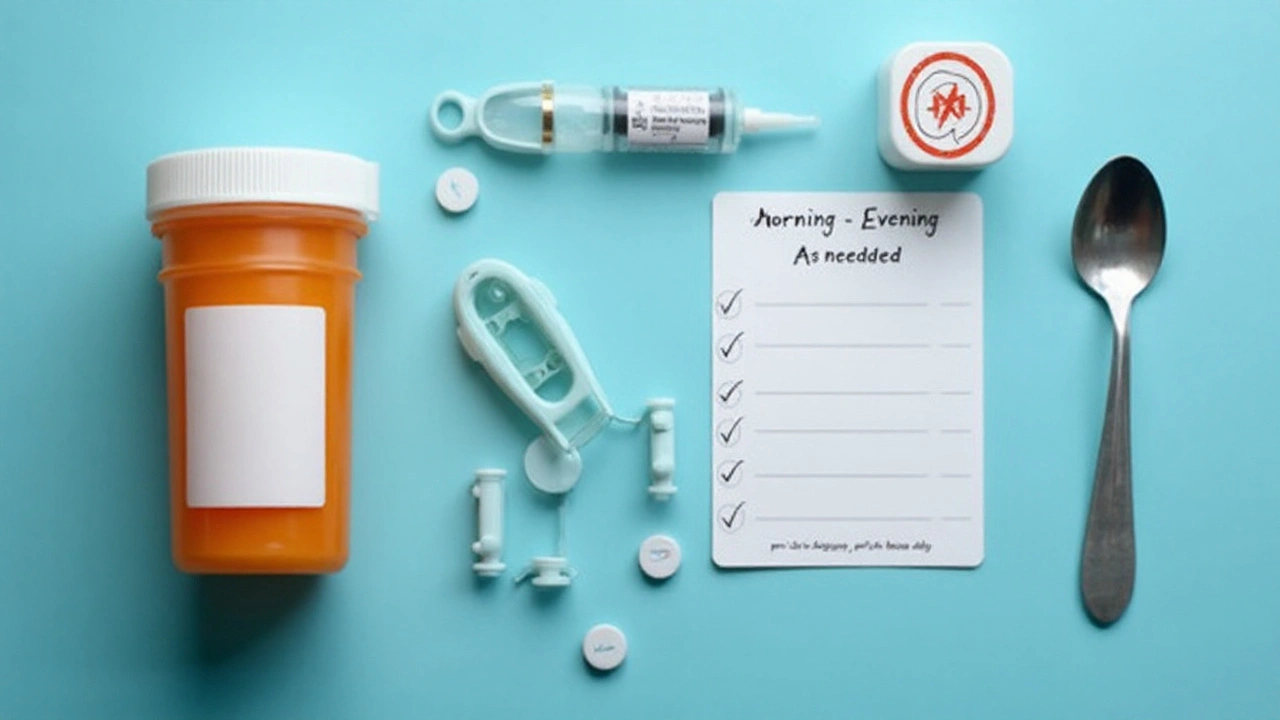Pharmacy Dictionary in Simple Terms: Plain-English Guide to Drug Labels and Terms

You shouldn’t need a medical degree to understand a medicine label. This plain-English pharmacy dictionary strips out jargon and shows you how to read prescriptions, dosing instructions, and common drug terms without guesswork. Expect clear definitions, real examples, quick checklists, and a few simple rules that keep you safe. I’ll lean on trusted sources like the HSE (Ireland), the NHS (UK), the EMA (EU), and the FDA (US) for facts. And yes-if anything here clashes with advice from your pharmacist or prescriber, their guidance wins.
TL;DR, Core Terms, and How to Read Labels
Key takeaways
- Active ingredient = the chemical that treats your condition; brand name = the marketing name.
- Strength tells you “how much per unit” (e.g., 500 mg per tablet or 250 mg per 5 mL).
- Modified-release (MR/XL/CR) tablets must not be crushed or chewed.
- Generics have the same active ingredient and work the same way as brand-name drugs; regulators require this (bioequivalence standards).
- Read labels in this order: who it’s for → what it is → how much → how often → how long → warnings.
The jobs you probably want to get done
- Decode common pharmacy and prescription terms quickly.
- Read a medicine label without missing anything important.
- Tell brand vs generic, dose vs strength, and when not to take something.
- Do simple dosing math (mg to mL) without panicking.
- Spot red flags: interactions, storage mistakes, and tablet forms you should not crush.
How to read a medicine label step-by-step
- Confirm it’s yours: name, date of birth, address if printed. If it’s for a child, check the child’s name.
- Find the active ingredient: e.g., paracetamol, amoxicillin, ibuprofen. This is what does the work.
- Check the strength: for tablets, it’s per tablet (e.g., 500 mg). For liquids, it’s per volume (e.g., 250 mg/5 mL).
- Read the dose: how many tablets/mL per dose (e.g., take 10 mL). Dose ≠ strength.
- Read the frequency: how often (e.g., every 8 hours, twice daily). Watch for time anchors like “with food” or “at night”.
- Duration: how long to take it (e.g., 7 days) or “as needed” (PRN) with limits.
- Warnings: interactions (“don’t take with other paracetamol”), driving/drowsiness, alcohol, pregnancy/breastfeeding notes.
- Storage: “store below 25°C,” “keep in original container,” “refrigerate after opening” for some liquids.
- Leftovers/disposal: bring unused/expired meds back to the pharmacy; don’t bin sharps; don’t flush.
Mini dictionary: the plain-English version
- Active ingredient: the chemical that treats your condition (e.g., paracetamol). Different brands can share one active ingredient.
- Brand name: the product’s marketing name (e.g., Panadol). Not the same as the active ingredient.
- Generic: a non-brand version with the same active ingredient, dose, and effect. Regulators require it to work the same.
- Strength: how much active ingredient per unit (e.g., 500 mg per tablet, 5 mg/mL).
- Dose: what you actually take each time (e.g., 10 mL or two tablets).
- Dosage: the plan that includes dose + frequency + duration (e.g., 10 mL every 8 hours for 5 days).
- Formulation: the format-tablet, capsule, liquid, cream, inhaler, patch, suppository.
- Immediate-release (IR): releases the drug quickly. Often you take it more often.
- Modified-release (MR, XL, LA, CR, SR): releases slowly. Do not crush or chew unless your pharmacist says it’s safe.
- Indication: what the medicine treats (e.g., pain, high blood pressure).
- Contraindication: a reason not to use it (e.g., serious allergy, certain health conditions).
- Precautions: situations where you need extra care (e.g., dose change with kidney problems).
- Side effect: an unintended effect. Many are mild; some are serious and rare.
- Adverse reaction: a harmful, unintended effect. Report serious ones to the regulator (HPRA in Ireland).
- Interaction: when two substances affect each other (e.g., grapefruit with some statins).
- OTC: over-the-counter-no prescription needed.
- Pharmacy-only (P medicine): no prescription needed, but only supplied by a pharmacist after a quick check (common in Ireland/UK).
- Prescription-only: you need a prescriber’s script; sometimes called POM (Prescription Only Medicine).
- Black triangle (EU/UK): ▼ symbol showing a new medicine is under extra monitoring.
- Bioequivalence: testing that shows a generic behaves the same in the body as the brand.
Regional tip: in Ireland and the UK, you’ll see “paracetamol.” In the US/Canada, the same active ingredient is called “acetaminophen.”

Safe Use: Doses, Interactions, and Pharmacy Math (Made Easy)
Five quick safety rules you can actually remember
- Right person: never share prescriptions. Names matter.
- Right drug: match the active ingredient; don’t double up two brands of the same thing.
- Right dose: check strength vs dose-easy to mix up.
- Right time: stick to frequency (e.g., every 8 hours). Set phone reminders.
- Right route: mouth (PO), under tongue (SL), inhaled, skin, rectal (PR), injection. Don’t swap routes without advice.
Label decoding for liquids
Liquid medicines print strength like “250 mg/5 mL.” That means every 5 mL has 250 mg of the drug. If your dose is 500 mg, you take 10 mL. Use an oral syringe or proper measuring cup, not a kitchen spoon (they vary a lot).
Simple dosing math you might need
- Convert mg to mL: Dose (mg) ÷ Strength (mg per mL) = mL to take.
- For strengths per 5 mL: First find mg per 1 mL, then divide. Example: 250 mg/5 mL = 50 mg/mL. Need 125 mg? 125 ÷ 50 = 2.5 mL.
- Kids’ doses by weight: If your prescriber says “X mg/kg,” multiply the child’s weight in kg by X to get the mg per dose, then convert to mL using the label strength. Confirm with your pharmacist if unsure. Always.
Abbreviations you’ll see (and what they really mean)
| Abbreviation | Plain meaning | Where you see it / Tip |
|---|---|---|
| OD | Once daily | Often morning; same time daily |
| BD | Twice daily | Roughly 12 hours apart (e.g., 8am/8pm) |
| TDS / TID | Three times daily | Every ~8 hours |
| QDS / QID | Four times daily | Every ~6 hours |
| PRN | As needed | Watch max doses per day |
| PO | By mouth | Tablets, capsules, liquids |
| SL | Under the tongue | Don’t swallow straight away |
| PR | Rectal | Suppositories |
| IM / IV / SC | Injection: muscle / vein / under skin | Healthcare setting or taught self-use |
| MR / XL / CR / SR | Modified/slow release | Do not crush/chew |
| HS | At bedtime | Night-time dose |
| ac / pc | Before meals / after meals | Time with food matters |
| q4h, q6h | Every 4 hours, every 6 hours | Keep intervals steady |
Interactions and rules of thumb
- Paracetamol vs ibuprofen: Paracetamol is usually gentler on the stomach; ibuprofen is an NSAID-avoid if you have certain stomach, kidney, or heart issues unless told otherwise. Source: HSE/NHS guidance.
- Grapefruit: Can boost blood levels of some drugs (e.g., certain statins, calcium channel blockers). If your leaflet says avoid grapefruit, avoid it fully. Source: EMA/FDA safety communications.
- Warfarin and vitamin K: Keep vitamin K intake steady; big swings can affect INR. Source: anticoagulation clinic protocols and HSE.
- Antibiotics and the pill: Most antibiotics do not reduce pill effectiveness, but enzyme-inducers like rifampicin do. Check your specific drug. Source: NHS/Faculty of Sexual & Reproductive Healthcare.
- Alcohol: Can worsen drowsiness with many meds and is a bad idea with metronidazole and some opioids and sedatives. Check the label.
Tablets you should not crush
- Anything labeled MR/XL/LA/CR/SR or “modified release.”
- Enteric-coated tablets (often marked “EC”).
- Capsules with tiny beads designed for slow release (sometimes can be opened and sprinkled as directed-ask first).
Storage and disposal
- Keep medicines in their original packaging, away from heat and damp. “Store below 25°C” shows up a lot in Ireland/UK.
- Refrigerate only if the label says so (some liquid antibiotics).
- Check expiry dates. Liquids often expire sooner after opening-your label may say “discard after 14 days.”
- Bring expired or unused meds back to the pharmacy. Don’t flush. Don’t use household bins for sharps.
Credibility note: The safety points above reflect guidance from the HSE, NHS, EMA, and FDA as of 2024-2025.

Cheat Sheets, Real-Life Examples, and FAQ
Quick checklists you’ll actually use
Before you start a new medicine
- What’s the active ingredient and strength?
- What’s my dose, how often, and for how long?
- Do I take it with food or on an empty stomach?
- Any “do not” warnings (driving, alcohol, sun sensitivity)?
- Could it clash with anything I already take, including herbal products?
- What side effects are common-and which rare ones mean call for help?
When to ask the pharmacist
- If you’re pregnant, breastfeeding, or dosing a baby/child.
- If you have kidney, liver, heart, or stomach problems.
- If the label doesn’t match what your doctor told you.
- If you’re struggling to swallow tablets-there’s often a liquid or dispersible version.
Real label walk-through: liquid antibiotic for a child
Imagine the label says: “Amoxicillin oral suspension 250 mg/5 mL. Give 5 mL three times daily for 5 days.”
- Active ingredient: amoxicillin.
- Strength: 250 mg in every 5 mL (50 mg per mL).
- Dose: 5 mL each time (that’s 250 mg per dose).
- Frequency: three times daily (roughly every 8 hours).
- Duration: 5 days-finish the course unless told otherwise.
- Tips: Shake the bottle well; use a syringe; some suspensions need refrigeration-check the label.
If the prescriber wrote a weight-based dose (e.g., “X mg/kg”), you’d multiply your child’s weight by X to get the mg per dose, then divide by 50 mg/mL to get mL. Not sure? Ask-pharmacists do this math daily.
Real label walk-through: pain relief for an adult
Label: “Paracetamol 500 mg tablets. Take 1-2 tablets every 4-6 hours as needed. Max 8 tablets in 24 hours.”
- Active ingredient: paracetamol.
- Strength: 500 mg per tablet.
- Dose: 1-2 tablets each time (500-1000 mg).
- Frequency: every 4-6 hours if needed.
- Max daily: 8 tablets (4,000 mg). Source: HSE/NHS standard adult maximum.
- Tip: Watch combination cold/flu products-they often contain paracetamol too.
What the big leaflets are trying to tell you (but faster)
- Who shouldn’t take it: allergies, certain conditions (e.g., ulcers for NSAIDs), interactions.
- How to take: with/without food, swallow whole vs allow to dissolve.
- Side effects: common (nausea, headache) vs serious (rash + breathing issues → emergency).
- What to do if you miss a dose: usually take when you remember unless it’s nearly time for the next-don’t double.
Mini-FAQ
- Are generics as good as brands? Yes. Regulators (EMA, FDA) require proof of bioequivalence-same active ingredient, strength, form, and effect within tight limits.
- Paracetamol vs acetaminophen-what’s the difference? None. Same active ingredient, different name. Ireland/UK: paracetamol. US/Canada: acetaminophen.
- Can I crush tablets? Only if your pharmacist says it’s safe. Never crush modified-release or enteric-coated tablets.
- What does “contains lactose/peanuts/soy” mean? Excipients (inactive ingredients) can matter for allergies/intolerances. Ask for an alternative if needed.
- Do antibiotics always affect birth control? No. Only some (like rifampicin/rifabutin) are proven to reduce effectiveness. Check your exact antibiotic with a pharmacist.
- How do I report a side effect in Ireland? Use the HPRA’s adverse reaction reporting system. Pharmacists can help you submit it.
- Is “drowsiness” normal with antihistamines? First-generation ones (e.g., chlorphenamine) can make you sleepy. Newer ones (e.g., cetirizine, loratadine) are usually less sedating.
- What’s “as directed” supposed to mean? It means the dose is in the prescriber’s instructions rather than printed detail on the label. If unsure, ring the pharmacy for the exact dose.
- Expired meds-always unsafe? Potency can drop after the expiry date; liquids can degrade once opened. For antibiotics and eye drops, be strict. When in doubt, return them and replace.
Red flags: stop and get help
- Signs of severe allergy: swelling of lips/face, wheeze, rash + difficulty breathing-call emergency services.
- Sudden severe rash with fever after a new drug-urgent medical review.
- Black, tarry stools or vomiting blood with painkillers-emergency assessment.
- Confusion, severe drowsiness, or breathing problems if mixing sedatives/alcohol-seek help fast.
Next steps and troubleshooting-pick your scenario
- Parent with a sick child: Get an oral syringe; write doses/times on a sticky note; weigh your child to the nearest 0.1 kg; ask the pharmacy to mark the correct mL on the bottle.
- Older adult managing many meds: Ask for a weekly blister pack; keep a one-page meds list; set alarms; book a Medicines Use Review if offered.
- New to a chronic med: Track your first two weeks-time taken, any side effects, how you feel. Bring that to your follow-up.
- Athlete worried about doping: Check your meds with your sport’s anti-doping list; many nasal sprays and inhalers are fine, but doses/forms matter.
- Travelling: Keep meds in original packs in carry-on; bring a printout of prescriptions; watch time zones for once-daily meds-shift gradually.
Why this dictionary is trustworthy
The definitions and rules here line up with guidance from: Health Service Executive (Ireland), National Health Service (UK), European Medicines Agency, Health Products Regulatory Authority (Ireland), and the US Food and Drug Administration. These bodies set or enforce the standards for how medicines are tested, approved, labeled, and monitored. If you need proof for a specific point (like maximum daily paracetamol dose or which antibiotics affect contraception), your pharmacist can point you to the exact document from those agencies.
Final note: if a label or leaflet still feels fuzzy, that’s normal-medicine language can be dense. Bring the box to your pharmacy and say, “Can you walk me through this?” That one-minute chat can save you hours of worry-and keep you safer than any online guide.